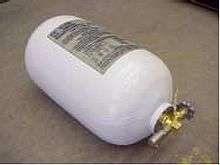Composite overwrapped pressure vessel
A composite overwrapped pressure vessel (COPV) is a vessel consisting of a thin, non-structural liner wrapped with a structural fiber composite, designed to hold a fluid under pressure. The liner provides a barrier between the fluid and the composite, preventing leaks (which can occur through matrix microcracks which do not cause structural failure) and chemical degradation of the structure. In general, a protective shell is applied for protective shielding against impact damage.[1][2] The most commonly used composites are fiber reinforced polymers (FRP),[3] using carbon and kevlar fibers. The primary advantage of a COPV as compared to a similar sized metallic pressure vessel is lower weight, but this may be offset by the increased costs of manufacturing and certification.


Overview
A composite overwrapped pressure vessel (COPV) is a pressure-containing vessel, typically composed of a metallic liner, a composite overwrap, and one or more bosses.[4] They are used in spaceflight due to their high-strength and low weight.[5]
During operation, COPVs expand from their unpressurized state.[6]
Manufacturing
During manufacturing, COPVs undergo a process called autofrettage. The unit is pressurized and the liner is allowed to plastically (permanently) deform. It comes into contact with the overwrap and results in a permanent volume increase. One reason to autofrettage a vessel is to verify the volume increase across pressure vessels in a product line remain within family. Out-of-family data could indicate possible damage to the vessel.[5][7]
Testing
Various tests and inspections are performed on COPVs, including burst test, stress-rupture lifetime, and nondestructive evaluation.[8][9]
Aging
Three main components affect a COPVs strength due to aging: cycle fatigue, age life of the overwrap, and stress rupture life.[4]
Failures
COPVs can be subject to complex mode of failures. In 2016, a SpaceX Falcon 9 rocket exploded on the pad due to the failure of a COPV inside the liquid oxygen tank[10] : the failure resulted from accumulation of oxygen between the COPV's aluminum liner and composite overwrap in a void or buckle. The entrapped oxygen can either break overwrap fibers or cause friction between fibers as it swells, igniting the fibers in the pure oxygen and causing the COPV to fail.
See also
- Gas cylinder – Cylindrical container for storing pressurised gas
- Fuel tank
- Hydrogen tank – Container for hydrogen storage
- Graphite-Epoxy Motor
References
- Protective shells for composite overwrapped pressure vessels
- Metal-Lined Composite-Overwrapped Pressure Vessel
- A STRUCTURAL HEALTH MONITORING SYSTEM FOR COMPOSITE PRESSURE VESSELS
- Russel, Rick. "Composite Overwrapped Pressure Vessels (COPV) Stress Rupture Test. Part 2" (PDF). NASA. Retrieved May 25, 2018.
- Kezirian, Michael T. "Composite Overwrapped Pressure Vessels (COPV): Flight Rationale for the Space Shuttle Program" (PDF). AIAA. Retrieved May 24, 2018.
- Tam, Walter H. "DESIGN AND MANUFACTURE OF A COMPOSITE OVERWRAPPED PRESSURANT TANK ASSEMBLY" (PDF). AIAA. Retrieved May 24, 2018 – via Orbital ATK.
- Pat B. McLaughlan; Scott C. Forth; Lorie R. Grimes-Ledesma (March 2011). "Composite Overwrapped Pressure Vessels, A Primer" (PDF). NASA. Archived from the original (PDF) on 2015-04-21.
- Vessel Testing Archived 2008-09-05 at the Wayback Machine
- "Stress-rupture lifetime testing". Archived from the original on 2010-05-27. Retrieved 2008-10-20.
- "SpaceX announces COPV's role in September rocket explosion". 01/02/2017.